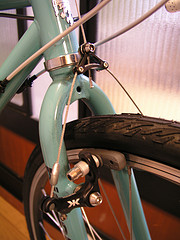
flic.kr/p/9Ugc5o
Remember when you were a kid, and you first dared to ride your bike down that truly steep hill in your neighbourhood? The ride going down can be a rush. Stopping isn’t always so much enjoyable. Bicycle control relies on two elements: brakes and steering. If either of these is missing, you are an out of control cyclist, dangerous to yourself and others.
History’s first bicycles do not have brakes. Band-aids hadn’t yet been invented, so the next logical step was to invent a stopping system. Thus, brakes were born to help riders slow down and stop, and bicycles suddenly became more well-known. By increasing frictional force on the wheels, cyclists were capable to slow down and stop.
The first widely used braking system was named “the plunger”. It first appeared on the high-wheeled bicycles that were famous in the 1800s. The plunger operated on a basic principle. To slow down a bicycle, a lever was either pulled up or pressed down, causing a metal show to press against the outer side of the tire. The friction created, of course, caused excess wear and tear on the tire. Cyclists discovered that the plunger did not work well with pneumatic tires, even after covering the metal shoe with rubber. Wet surfaces were another drawback, as water reduced the friction between the brake shoe and tire, decreasing the braking power.
The next major improvement in bicycle brakes was the “coaster brake”. Most of us have used coaster brakes, still famous in pint-size toddler bikes and tricycles. Some cruisers and utility bicycles also use coaster brakes. The idea behind coaster brakes is simple reverse motion. When the pedals are moved in a reverse direction, the brake mechanism inside the hub of the wheel pushes outward, producing friction and slowing down the bike. Coaster brakes are quite strong and tend to lock up and skid the rear wheel when engaged, so they’re great options for sidewalk burnouts.
Most of today’s road, mountain and stunt bikes use caliper rim brakes. Generally, by pulling a lever, a cable is tightened. This cable then forces the brake shoes or pads to press against the inner rim of the wheel, stopping the bike. Caliper bicycle brakes are light and relatively inexpensive, but they do come with their own set of troubles. Not hugely efficient on rainy days, wet brakes take twice as long to stop a bicycle because the water decreases friction between the brake and the wheel. Caliper brakes work best when pressure is applied lightly.
|
Learn how to ride faster than you ever thought possible |
It is critical to balance the braking between the front and rear brakes while riding. If too much brake pressure is applied to the front wheel, your body inertia and momentum will take you right over the handlebars.
Over the decades, braking systems and materials have changed, but the basics of slowing and stopping a bicycle have not. Bicycle brakes are still based on the idea of friction, and are still vitally important to your safety.
Tagged with: bicycle parts • bicycle type
Filed under: Bikes